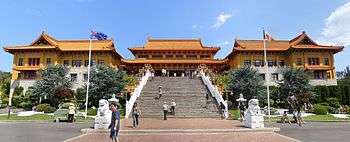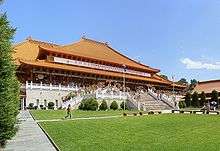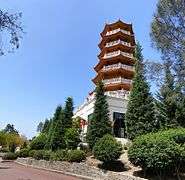Nan Tien Temple

Nan Tien Temple (Chinese: 南天寺; pinyin: Nántiān Sì; literally: "Southern Heaven Temple") is a Buddhist temple complex located in the industrial suburb of Berkeley, on the southern outskirts of the Australian city of Wollongong, approximately 80 km south of Sydney. Nan Tien is a Chinese term which means "southern paradise".[1]
Nan Tien is one of the branch temples of the Taiwanese Fo Guang Shan Buddhist order, founded in 1967 by Hsing Yun,[2] which has over 120 branches worldwide. The temple is one of the largest Buddhist temples in the southern hemisphere.[3] N1
History



It was founded by and constructed under the auspices of the Mahayana Buddhist organization known as Fo Guang Shan, and completed in 1995. The organization itself was founded in Taiwan in 1967 by Venerable Master Hsing Yun, and has 120 branches throughout the world. Fo Guang Shan Buddhism is rooted in the Mahayana tradition which emphasises that Buddhahood is within everyone's potential reach. Fo Guang Shan followers strive to bring Buddhism into daily life and describe their philosophy as "Humanistic Buddhism."
The site of the Australian branch's temple was reputedly chosen by Hsing Yun due to its proximity to Mount Kembla, which is said to have an auspicious resemblance to a recumbent lion. It overlooks both Mount Keira and Mount Kembla. The land was donated by the Australian government.
Temple complex
The Nan Tien complex was built using traditional techniques and materials by Chinese craftsmen, but with numerous modern features. Occupying a semi-rural hillside site several square kilometres in size, and set amidst landscaped gardens.
In addition to various meeting rooms, a museum, cultural, conference and accommodation facilities and a restaurant, the Nan Tien temple complex includes two massive prayer halls (known as the Great Mercy Shrine and the Great Hero Hall) within which are located multiple monumental Buddha and Bodhisattva statues, as well as an 8 level pagoda, serving as a columbarium intended to house the cremated remains of 7000 people. The front hall houses the Thousand Handed Avalokitesvara (known as Kuan Yin in Chinese culture) and the main hall in the back houses the Five Dhyani Buddhas, Amogasiddhi, Ratnasambhava, Vairocana, Amitabha and Akshobhya. Both halls have thousands of tiny statues of Buddha on the walls. The complex also has amenities for monks, nuns and visitors, and a large garden with a pagoda.
The architecture of the complex is notable because it incorporates the features of several styles of Buddhism. The pagoda is distinctly Chinese, with flying eaves and an angular profile. The main temples incorporates features of Tibetan monastic architecture, with multi-storey painted temple buildings set atop high stone platforms (see the Potala Palace). The courtyards feature Japanese-style gardens, while the statues and shrines often incorporate bright, South-East Asian colour schemes, in contrast to the more austere styles favoured in China.
Tourism
The temple is one of Wollongong's major tourist attractions, and conducts regular weekend retreats for visitors interested in Buddhism in general, and Chinese culture in particular. Retreats can involve classes in t'ai chi, calligraphy and meditation.
Accommodation for retreat participants and members of the general public is available at the Pilgrim Lodge, a 100-room motel-style facility located in the temple grounds adjacent to its large lotus pond.
It is regarded as an "orthodox" Buddhist temple by local Chinese Buddhists, in contrast with some other shrines which worship Buddhist, Taoist, and mystical heroes in the same building. It frequently hosts festivals.
University
Construction started in November 2012 on a $40 million expansion for the Nan Tien Institute (NTI); Australia's first government accredited tertiary institution grounded in Buddhist values and wisdom. Subjects includes: Buddhist Studies, Health and Social Well-being. Future courses include: Arts, Education, Human Welfare, Health and Religions. The construction is expected to be completed in September 2014 and ready for the first semester in March 2015.
See also
- Hsing Yun
- Hsi Lai Temple
- Nan Hua Temple
- Great Stupa of Universal Compassion
- Jade Buddha for Universal Peace

Notes
- ^N1 The Nan Tien Temple's website states that it is the largest in the southern hemisphere, but the basis of this claim is unclear.
References
External links
| Wikimedia Commons has media related to Nan Tien Temple. |
- Nan Tien Temple website.
- Nan Tien Institute website
- Nan Tien Photos
- An interactive 360° panorama of the courtyard
- Sydney Mate on Nan Tien
Coordinates: 34°28′00″S 150°50′55″E / 34.46667°S 150.84861°E